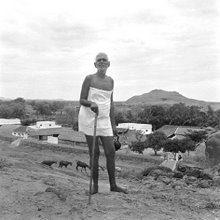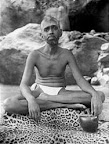DID a jnani [?] need tapas [?]? Venkataraman had already realized the supreme Self. There was no need for any further effort. But for convenience we shall use the expressions "tapas [?]" and "initiation." Readers must not get misled.
On the very day Venkataraman left his family and offered himself to Arunachaleswara all connection with his earlier life was torn asunder. Yet a few symbols remained. Why retain even them? He had only to be in the bliss of Self knowledge as nothing else was needed. He would tolerate nothing that came in its way. This was the only tapas [?] the only initation (diksha). His earlier life ended. Only abidance in the Self remained.
The sastras say that for initiation a guru is necessary.
For Venkataraman the guru was Arunachaleswara Himself. Ordinarily the guru initiates by touching various parts of the disciple's body and teaches him a mantra. His Father initiated him by just a look and like Dakshinamurti gave him a message through silence.
Venkataraman began discarding the symbols of his earlier life. Some he rid himself of by his own will, others left him on their own. With that, his outward life and inner life became synchronized.
Venkataraman tore and threw away the piece of paper on which Muthukrishna Bhagavatar gave his address at Kilur itself but the packet of sweets and a little money were still with him.
After offering himself at his Father's feet in the Arunachaleswara temple, Venkataraman came out into the vast temple of the world. He walked about aimlessly and reached the Ayyankulam Tank to the east of Arunachala. He noted that he still had the packet of sweets, "Does this need the sweets too?" he thought and flung it into the tank. Right from his younger days, Venkataraman had thick black hair. It was a natural embellishment. Did the body need any decoration at all? And why take the trouble of taking care of it? As he was returning from the tank, somebody asked him whether he would be interested in having his head shaved. Venkataraman assented and that stranger took him to the house of barber who usually worked at the temple. The stranger disappeared. Why did he ask Venkataraman whether he wanted his hair removed? The barber told Venkataraman that normally he would charge a higher amount for those wanting a tonsure at the temple but that he would give a concession to Venkataraman. He completed the tonsure in no time.
Venkataraman walked around and reached a garden to the east of the tank. There he tore away his clothes except for a codpiece and threw the rest into the tank. Wearing a codpiece is symbolic of chastity in word, thought and deed. The Father had vanquished Desire (kama [?]). Could the son be any different? Venkataraman threw away the little money still left with him.
The yagnopaveetam (sacred thread) is indicative of a Brahmin birth and culture — this indicated that Venkataraman was a Brahmin, son of Sundaram Iyer. Henceforth he was the son of the Universal Father, Arunachaleswara. He was beyond all caste distinctions. The sacred thread could also cause a sense of superiority. Hence, he got rid of it.
After his tonsure he did not want the luxury of a bath, but would the guru Arunachaleswara allow any violation of convention? Venkataraman took to sannyasa [?] in the midst of water. As he was returning to the temple, there was a heavy downpour drenching him. The heavens themselves provided the bath.
Venkataraman did not visit the temple sanctum during the next three years. There was no need for it. After all, the Father was present in the cave of his heart.
Venkataraman avoided speaking to anyone as he did not wish to have anything to do with people. Speaking itself became impossible. When he was always immersed in the Self and never even looked at the outside world how could he speak? This silence went beyond mere voice and touched the Self. Two years later, even when the Swami wanted to speak he could not as the words did not emerge clearly. It was only much later that normalcy was restored. Quite unintentionally silence itself became his characteristic. The Swami once said that silence should be the sadhaka's aim and that it would become the siddha's characteristic. But in his case, silence became his characteristic even without his passing through the sadhaka's phase. This is how he had initiation. What about life in the world? As long as the body was there it needed nourishment. After all, the body is the instrument of all sadhana [?]. But Venkataraman paid no heed to that thought — for him whatever happened to the body was the responsibility of the Father. The one who provided sustenance to the birds, fish and the other animals would surely not neglect him!
The Swami chose the temple for his dwelling. For a sannyasi, the caves of a hill, the banks of a tank, a temple, the trees of a forest — are all suitable say the sastras.
Referred Resources:
Links to letters:
Links to rl:
Ayyankulam: (Chapter 11: The Goal
Links to sp:
Links to gems:
renunciation: (Chapter 10: Renunciation





No comments:
Post a Comment